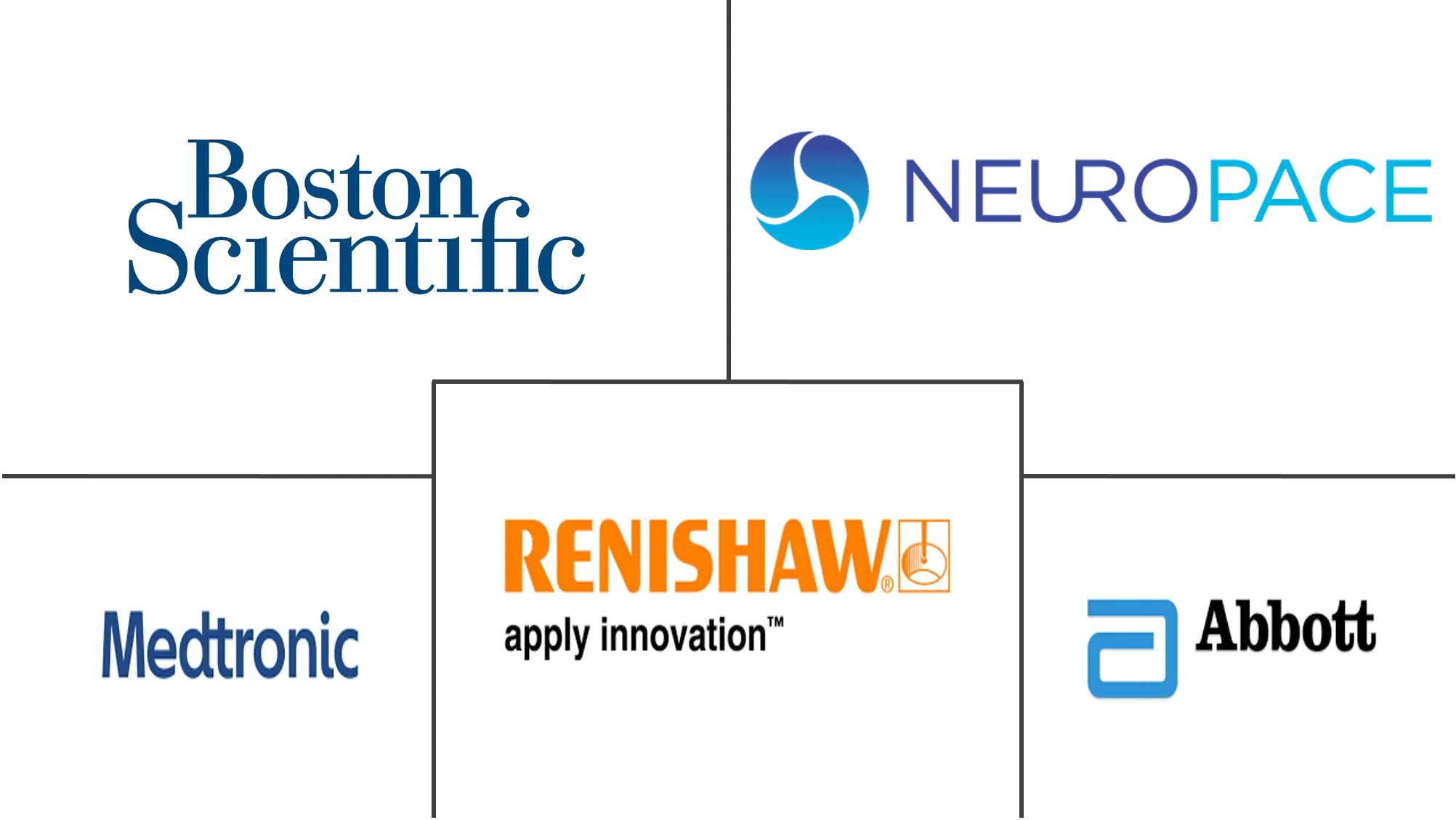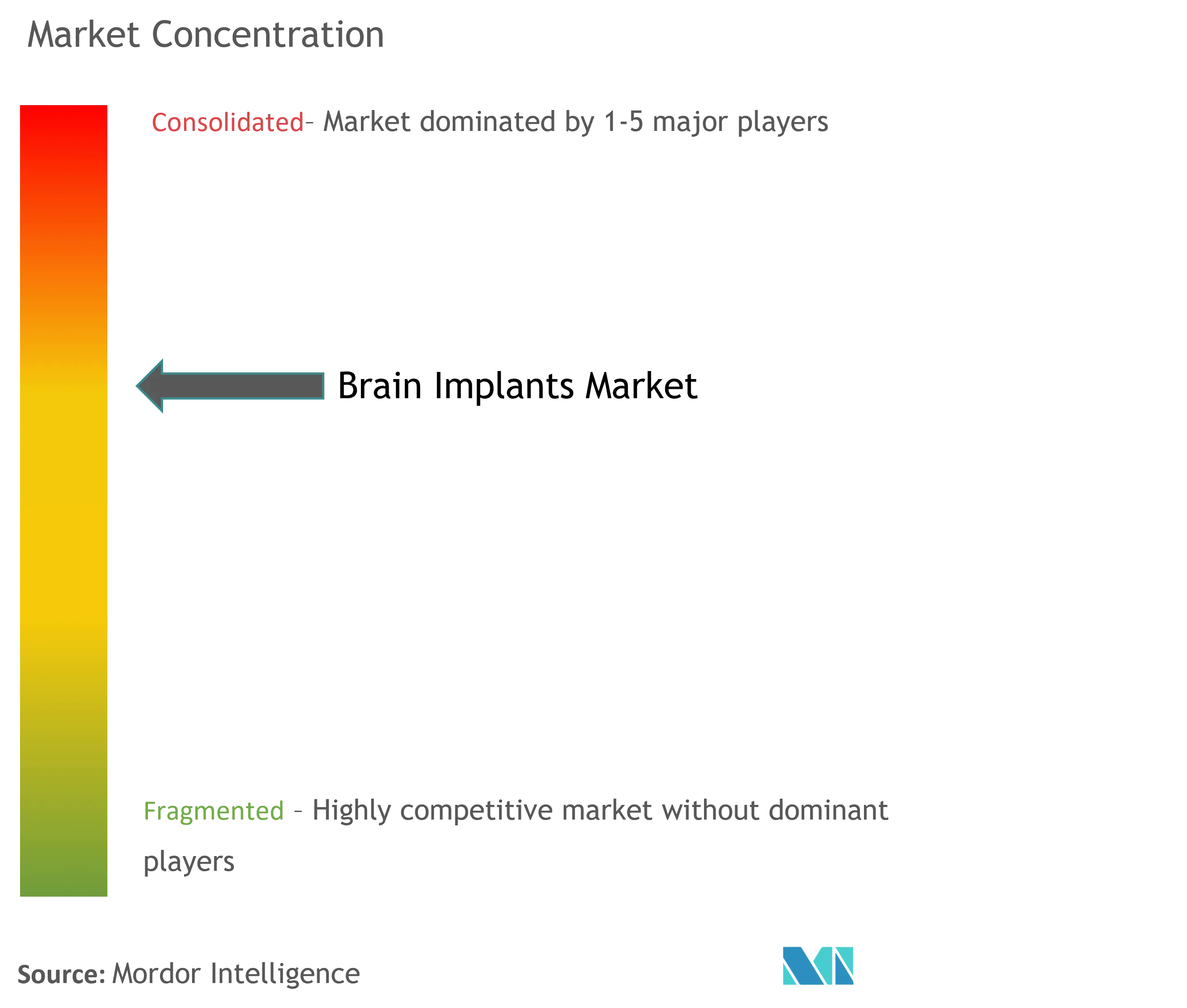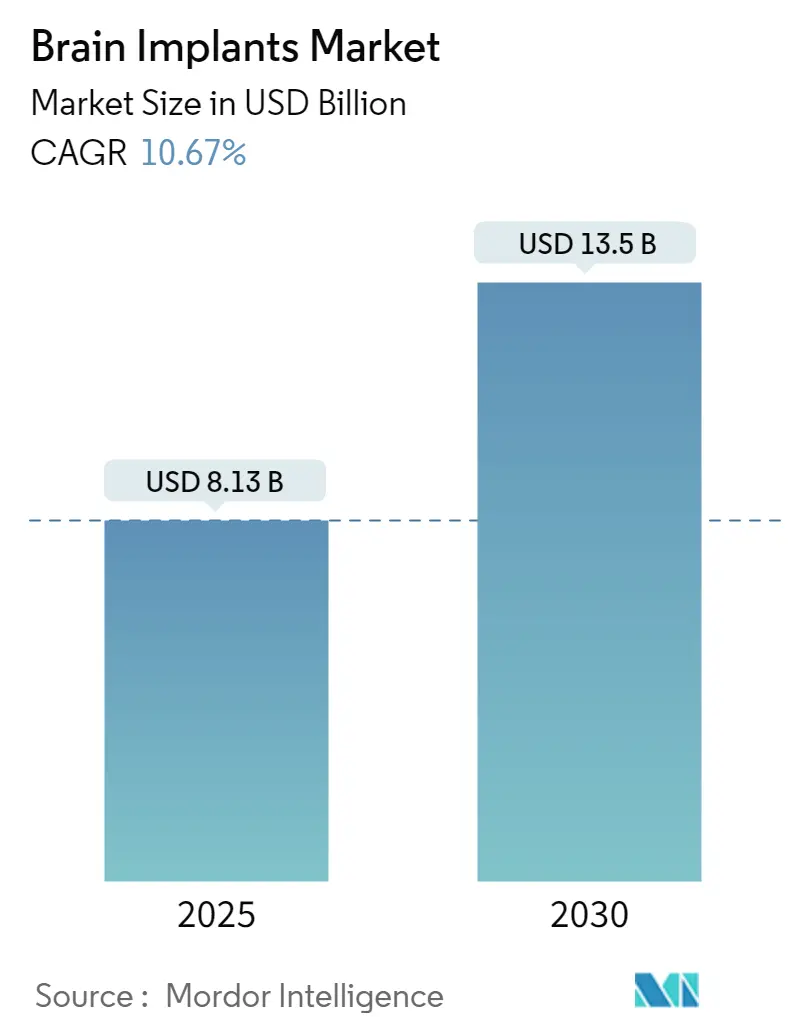
Brain Implants Market Analysis
The Brain Implants Market size is estimated at USD 8.13 billion in 2025, and is expected to reach USD 13.50 billion by 2030, at a CAGR of 10.67% during the forecast period (2025-2030).
The COVID-19 pandemic significantly impacted the growth of the brain implants market globally, due to the suspension and postponement of most elective surgeries and treatments. According to a research article published in medRXiV, 2021, the prevalence of SARS-COV2 viral infection in patients with Parkinson's disease was found to be 11.28%. Further, COVID-19 prevalence in Parkinson's disease patients with deep brain stimulation was found to be 18.18%. Thus, patients suffering from COVID-19 are prone to a high risk of developing neurological disorders during their hospital stays. The strict lockdown restrictions and measures taken to contain the viral transmission increased the chronic stress and burden of neurological disorders. This increased the urgent opening of neurological outpatient services. Thus, the brain implant market was significantly impacted during the pandemic. However, neurological surgeries evolved during the pandemic. For instance, in March 2021, an article published in Springer Nature Limited stated that the neurosurgical community's response to the initial phase of the pandemic, in at least three European countries, maintained high standards of care and low rates of acute mortality. Similarly, another article published in Frontiers Media S.A. in December 2021 stated that the deployment of telemedical services for patients with neurological and psychiatric conditions dramatically escalated as the pandemic evolved. Despite concerns about the format, scheduling, privacy, and reimbursement, the transition was relatively smooth with numerous reports underscoring patient satisfaction. Thus, the normalization of surgeries and the introduction of new methods are expected to increase market growth.
The major factors for the growth of the brain implant market include the rise in the aging population and an increase in the prevalence of neurological disorders and technological advancements in devices. The increase in the number of cases of neurological disorders, such as Alzheimer's, epilepsy, Parkinson's, depression, and essential tremors, is anticipated to propel the demand for brain implants. According to Parkinson's News Today 2021, an estimated 7 to 10 million people worldwide have Parkinson's disease, and approximately 60,000 Americans are diagnosed with this disease, thus, leading to promising growth. Similarly, according to the Parkinson's Foundation 2020, approximately 1.2 million people in the United States are estimated to suffer from Parkinson's disease by 2030. Brain implants are likely to reduce the need for drugs that relieve chronic pain and improve body movement in patients suffering from Parkinson's or any other neurological disease.
The growing geriatric population is also prone to several neurological disorders. According to the World Health Organization (WHO) October 2021 updates, around 1 in 6 people in the world will be aged 60 years or over by 2030, and by 2050, two-thirds of the world's population over 60 years will live in low- and middle-income countries. In such middle income countries the current infrastucture is not capable to provide care and constant monitoring and brain implants could provide that in such regions. Thus, the rising geriatric population, the brain implants market is expected to register significant growth over the forecast period.
Furthermore, collaborations by key market players are expected to increase the market growth as collaborations provide synergy of research and devlopment and required investment which increases the success rate of the program. For instance, in April 2022, a collaborative project between Queensland Brain Institute (QBI) together with Neurosciences Queensland and Abbott Neuromodulation developed a remote care platform that uses wireless technology in brain implant technology to allow patients to access treatment from anywhere in the world. This new technology will link to developing brain-reading devices, such as implants in the brain. Thus, the abovementioned factors such as the increasing prevalence of neurological disorders and collaborations are expected to increase market growth over the forecast period. However, the high cost of devices and low adoption rates in developing and underdeveloped regions are expected to hinder the market growth.
Brain Implants Market Trends
Alzheimer’s Diseases is Expected to Hold Significant Growth in the Brain Implants Market Over the Forecast Period
Alzheimer's disease is a neurological disease that impacts the memory of the patient and often deteriorates with time. Factors such as the increasing prevalence of Alzheimer's disease coupled with increasing initiatives such as grants are expected to increase the market growth. The incidence of Alzheimer's has been constantly increasing, and it is expected to continue increasing in the coming decades. The Alzheimer's Association's 2021 report titled Alzheimer's Disease Facts and Figures stated that an estimated 6.2 million Americans aged 65 and older were living with Alzheimer's dementia in 2021 in the United States. By 2050, the number of people aged 65 and older with Alzheimer's dementia is projected to increase to 12.7 million. According to the World Alzheimer Report published in September 2021, over 55 million people live with dementia worldwide. This is forecasted to reach 78 million by 2030. Among all dementia conditions, 60-70% of cases account for Alzheimer's disease. Various research studies provide insight into the effects of brain implants on Alzheimer's disease. For instance, in November 2022, a study published in the Journal of Neural Engineering stated that the team developed deep learning methods that could detect seizure events with a sensitivity between 87.4% and 97.6 %. The team also is addressing the application of such therapies to Alzheimer's disease. 'Impaired sleep has been associated with Alzheimer's, and many people suffer from different levels of sleep disorders. Hence, brain implants may improve cognitive function in people with Alzheimer's disease, which is why Alzheimer's patients prefer brain implant procedures. Hence, the increasing number of people with Alzheimer's disease is expected to drive the brain implants market during the forecast period.
Additionally, increasing grants for research related to Alzheimer's disease are another factor in market growth. In April 2021, the government invested USD 30 million to Brown University for establishing a new Center for Alzheimer's Disease Research to build a world-class research program focused on the early detection and treatment of Alzheimer's disease. In January 2021, Cognito Therapeutics received a breakthrough device designation by the United States Food and Drug Administration (FDA) for its neurostimulation device to treat memory and cognition symptoms of Alzheimer's disease. Thus, the high incidence of Alzheimer's disease, along with the growing investments, is expected to help in the significant growth of the segment over the forecast period.
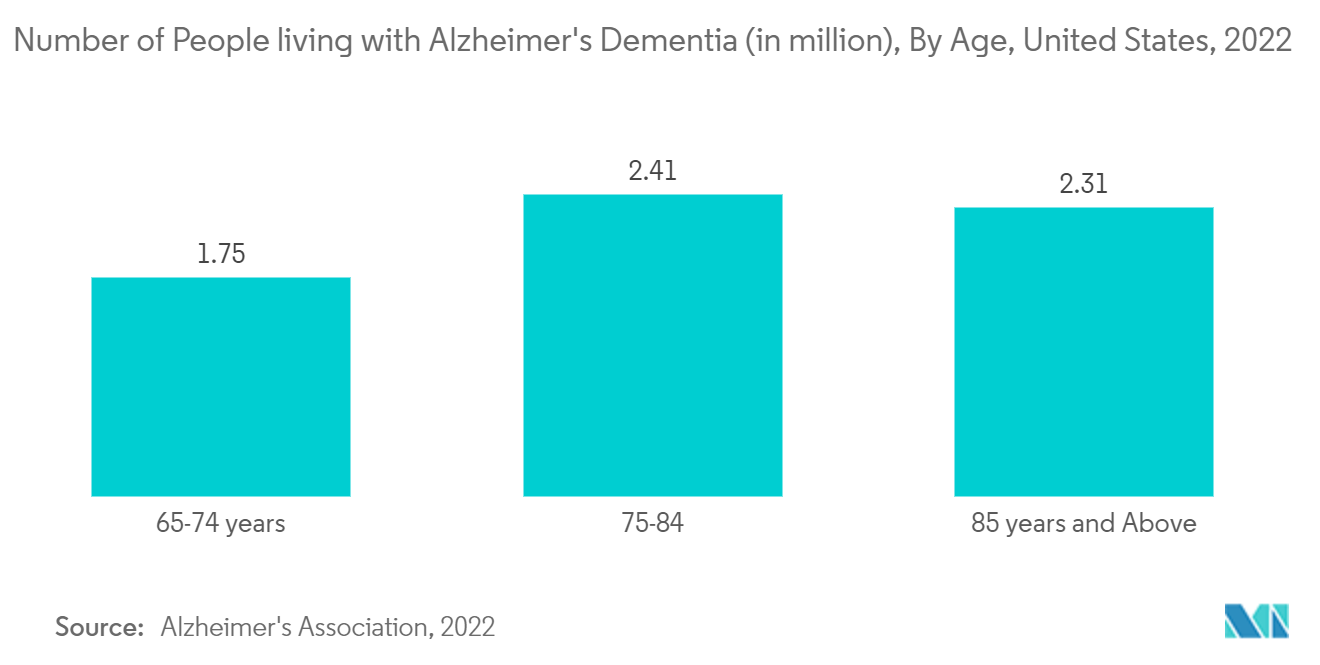
North America Region is Expected to Hold a Significant Market Share in the Brain Implants Market Over the Forecast Period
North America holds a significant share of the brain implant market. It is expected to show a similar trend over the forecast period, without significant fluctuations. The healthcare facilities in the country are of the highest standards and are accessible to the large population, due to favorable policies making healthcare affordable to the majority of the population in the region. This factor helps in gaining higher selling rates across the country. The increasing prevalence and incidence of various neurological disorders indicate a big potential for the market demand for brain implants. According to the Alzheimer's Disease Facts and Figures report by Alzheimer's Association 2022, an estimated 6.5 million Americans aged 65 and older are living with Alzheimer's dementia in 2022. And about 1 in 9 people aged 65 and older has Alzheimer's dementia. Similarly, as per the Alzheimer's Association 2022 report, the projected number of Alzheimer-related deaths in Mexico during the past year was 43,000 whereas, it is expected to reach up to 53,000 by the year 2025. Hence, the need to diagnose and treat these diseases gives rise to the demand for neurological treatment involving brain implants, which is expected to increase the number of product manufacturing companies in the country. Due to the increasing number of cases of neurological disorders, the market in the North American region, particularly in the United States, is expected to grow at a steady rate in the coming years.
Furthermore, approval for brain implants is expected to increase the market growth. As product approvals of brain implants are expected to increase its adoption for neurological disorders. For instance, in October 2022, Axoft, a neurotechnology company, received FDA Breakthrough Device designation for its brain-machine interface (BMI) to better treat neurological disorders. The company secured USD 8 million in capital to fund pre-clinical studies with the FDA and to scale up prototypes of its neural implants "as soft as the brain." Thus, owing to the aforementioned factors such as the increasing prevalence of neurological disorders and product approvals, the North American brain implants market is expected to witness significant growth over the forecast period.
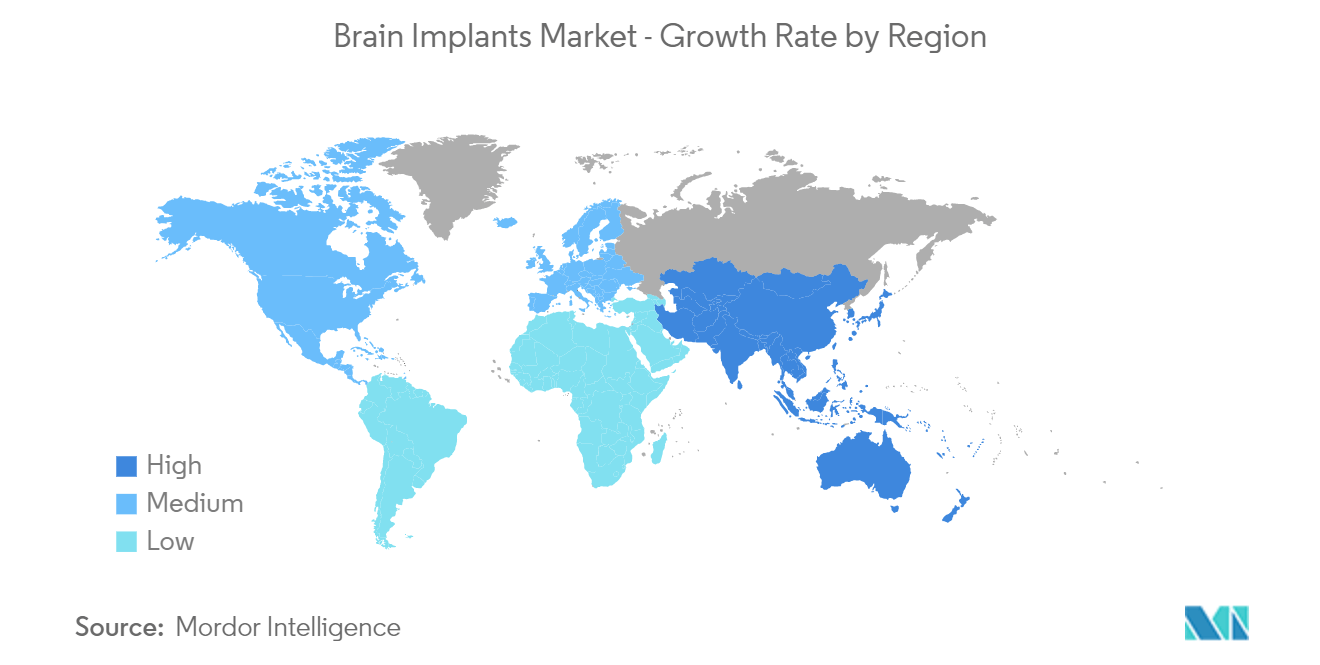
Brain Implants Industry Overview
The brain implant market is moderately consolidated with the presence of a few key players. Some of the market players are Abbott Laboratories, Boston Scientific Corporation, LivaNova PLC, Medtronic PLC, NDI Medical PLC, NeuroPace Inc., NeuroSigma, Synchron Inc., and Renishaw PLC.
Brain Implants Market Leaders
-
Boston Scientific Corporation
-
Medtronic PLC
-
NeuroPace Inc.
-
Renishaw PLC
-
Abbott Laboratories
- *Disclaimer: Major Players sorted in no particular order
Brain Implants Market News
- In July 2022, Synchron conducted the first human-brain-computer interface (BCI) implant procedure in the United States. This procedure represents a significant technological milestone for scalable BCI devices and is the first to occur in the United States using an endovascular BCI approach, which does not require invasive open-brain surgery.
- In January 2022, Elon Musk's Neuralink started clinical trials of implanting brain chips in humans to be able to communicate with machines by thought.
Brain Implants Industry Segmentation
As per the scope of the report, brain implants also referred to as neural implants are devices that are used to stimulate certain parts of the brain to stimulate senses, improve physical function, and enhance memory. The Brain Implants Market is Segmented by Product Type (Deep Brain Stimulator, Spinal Cord Stimulator, and Vagus Nerve Stimulator), Application (Chronic Pain, Epilepsy, Parkinson's Disease, Depression, Essential Tremor, Alzheimer's Disease, and Other Applications), and Geography (North America, Europe, Asia-Pacific, Middle East and Africa, and South America). The market report also covers the estimated market sizes and trends for 17 different countries across major regions, globally. The report offers the value (in USD million) for the above segments.
| By Product Type | Deep Brain Stimulator | ||
| Spinal Cord Stimulator | |||
| Vagus Nerve Stimulator | |||
| By Application | Chronic Pain | ||
| Epilepsy | |||
| Parkinson's Disease | |||
| Depression | |||
| Essential Tremor | |||
| Alzheimer's Disease | |||
| Other Applications | |||
| Geography | North America | United States | |
| Canada | |||
| Mexico | |||
| Europe | Germany | ||
| United Kingdom | |||
| France | |||
| Italy | |||
| Spain | |||
| Rest of Europe | |||
| Asia-Pacific | China | ||
| Japan | |||
| India | |||
| Australia | |||
| South Korea | |||
| Rest of Asia-Pacific | |||
| Middle East and Africa | GCC | ||
| South Africa | |||
| Rest of Middle East and Africa | |||
| South America | Brazil | ||
| Argentina | |||
| Rest of South America | |||
Brain Implants Market Research FAQs
How big is the Brain Implants Market?
The Brain Implants Market size is expected to reach USD 8.13 billion in 2025 and grow at a CAGR of 10.67% to reach USD 13.50 billion by 2030.
What is the current Brain Implants Market size?
In 2025, the Brain Implants Market size is expected to reach USD 8.13 billion.
Who are the key players in Brain Implants Market?
Boston Scientific Corporation, Medtronic PLC, NeuroPace Inc., Renishaw PLC and Abbott Laboratories are the major companies operating in the Brain Implants Market.
Which is the fastest growing region in Brain Implants Market?
Asia-Pacific is estimated to grow at the highest CAGR over the forecast period (2025-2030).
Which region has the biggest share in Brain Implants Market?
In 2025, the North America accounts for the largest market share in Brain Implants Market.
What years does this Brain Implants Market cover, and what was the market size in 2024?
In 2024, the Brain Implants Market size was estimated at USD 7.26 billion. The report covers the Brain Implants Market historical market size for years: 2021, 2022, 2023 and 2024. The report also forecasts the Brain Implants Market size for years: 2025, 2026, 2027, 2028, 2029 and 2030.
Our Best Selling Reports
Brain Implants Industry Report
Statistics for the 2025 Brain Implants market share, size and revenue growth rate, created by Mordor Intelligence™ Industry Reports. Brain Implants analysis includes a market forecast outlook for 2025 to 2030 and historical overview. Get a sample of this industry analysis as a free report PDF download.

